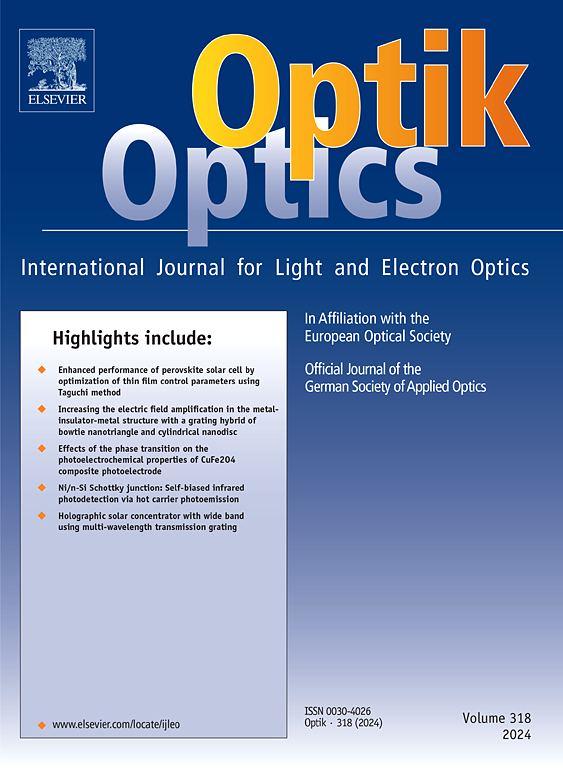Design of multilayer graphene metamaterials plasmonic waveguides with ultra-low-loss mid-infrared
IF 3.1
3区 物理与天体物理
Q2 Engineering
引用次数: 0
Abstract
In this the paper, a multilayer graphene metamaterials plasmonic waveguide (MGMPW) with ultra-low-loss has proposed in mid-infrared range. The MGMPW structure consisting of a porous stratum placed between multilayer graphene metamaterials with low index dielectric, and a high index dielectric nano-rib geometry, which both placed on a Magnesium fluoride substrate. The surface plasmon polaritons (SPPs) modes are supported by the multilayer graphene metamaterials with coupling plasmon polaritons at separate graphene layers over the high index dielectric nano-rib structure. Thus, the energy density in the proposed waveguide hardly confined in the area between the high index dielectric nano-edge Aluminum Oxide () and the multilayer graphene metamaterials. In the designed waveguide SPPs mode can be obtained the propagation length of nearly 100 µm and the normalized mode area of by tunning the values of the waveguide geometry and material parameters. The modal properties of the MGMPW are simulated using technique of the finite element. The dependence of modal characteristics is obtained on the wavelength of incident light, the graphene Fermi energy, and the dimensions of the waveguide geometry in detail. Furthermore, the crosstalk between two adjoining proposed structure is studied to show the SPPs strong squeeze to apply components of photonic integrated circuits.
超低损耗中红外多层石墨烯超材料等离子体波导的设计
提出了一种中红外超低损耗多层石墨烯超材料等离子体波导(MGMPW)。MGMPW结构由多孔SiO2层组成,置于多层石墨烯超材料之间,具有低折射率电介质和高折射率电介质纳米肋几何形状,两者都放置在氟化镁(MgF2)衬底上。表面等离子激元(SPPs)模式是由多层石墨烯超材料在高折射率介电纳米肋结构上的不同石墨烯层上耦合等离子激元来支持的。因此,所提出的波导中的能量密度几乎不局限于高折射率电介质纳米边缘氧化铝(Al2O3)和多层石墨烯超材料之间的区域。在设计的波导中,通过调整波导的几何形状和材料参数,可以获得近100 μ m的SPPs模式传播长度和~ 10−7的归一化模式面积。采用有限元技术对MGMPW的模态特性进行了模拟。得到了模态特性与入射光波长、石墨烯费米能量和波导几何尺寸的详细关系。此外,研究了两个相邻结构之间的串扰,以证明SPPs的强挤压可以应用于光子集成电路的元件。
本文章由计算机程序翻译,如有差异,请以英文原文为准。
求助全文
约1分钟内获得全文
求助全文
来源期刊

Optik
物理-光学
CiteScore
6.90
自引率
12.90%
发文量
1471
审稿时长
46 days
期刊介绍:
Optik publishes articles on all subjects related to light and electron optics and offers a survey on the state of research and technical development within the following fields:
Optics:
-Optics design, geometrical and beam optics, wave optics-
Optical and micro-optical components, diffractive optics, devices and systems-
Photoelectric and optoelectronic devices-
Optical properties of materials, nonlinear optics, wave propagation and transmission in homogeneous and inhomogeneous materials-
Information optics, image formation and processing, holographic techniques, microscopes and spectrometer techniques, and image analysis-
Optical testing and measuring techniques-
Optical communication and computing-
Physiological optics-
As well as other related topics.
 求助内容:
求助内容: 应助结果提醒方式:
应助结果提醒方式:


